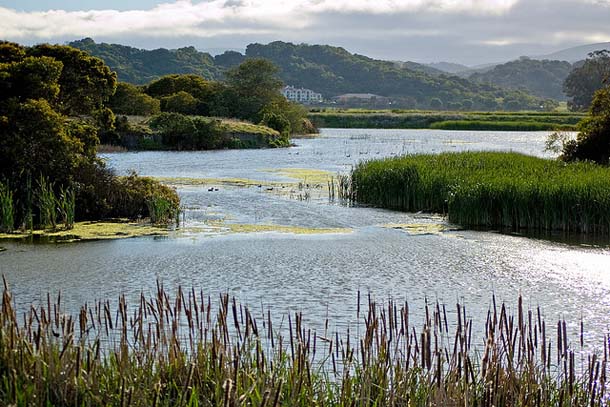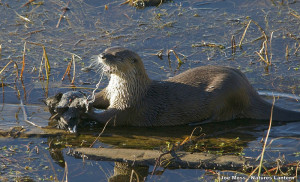In the Bay Area, it’s a sound heard all year long. Golf courses, parks and playing fields throughout the region host resident populations of the western Canada goose, a handsome, heavy-bodied bird with a distinctive black neck and white cheek patches.
While some of the birds migrate via the Pacific Flyway to summer breeding grounds in Canada and the northern U.S., others take advantage of the absence of predators, abundant food, and ideal nesting habitat and stay put.
“We’ve made it so comfortable for them to reside here,” says Denise Laberee, co-owner of 4 Paws Goose Control. Laberee takes trained border collies and Labrador retrievers to sites with goose problems.
Geese like open, grassy areas with access to nearby water. Many people enjoy geese at their local park, especially during the breeding season, when pairs can be seen leading fluffy goslings to the water.
“We’re not talking about five to 10 birds. It’s more like 200 to 300,” says Laberee, whose clients include municipalities, golf course managers and homeowner’s associations.
Once a population establishes, it can spike dramatically in a short period of time. Geese are monogamous and long-lived. In fact, one female goose can produce 50 young over the course of her lifetime. And in the absence of predators, mortality is low.
“They’re pretty good at reproducing,” says Mark Williams, general manager of the Las
Gallinas Valley Sanitary District in Marin. He has witnessed the phenomenon first-hand at the wastewater treatment plant’s storage and wildlife ponds, which host a resident population of nearly 250 Canada geese. He worries the population will explode if left alone, potentially out-competing other bird species that use the ponds.
“We’re also concerned we’re going to have some type of bird flu,” Williams says. A high concentration of geese increases the likelihood of an outbreak of disease among them, which could then be transferred to other species.
It’s hard to believe now, but the Canada goose was in serious decline at the turn of the 20th century. The Migratory Bird Treaty Act of 1918 banned hunting or the taking of eggs without a permit. These protections, combined with an increase in desirable real estate—parks, golf course and the like—spurred a dramatic turnaround for the species. Canada geese began breeding in the Bay Area—the southern end of their range – in the late 1950s.
Case in point, the athletic fields at Tamalpais High School in Mill Valley host a healthy flock of geese. In the aftermath of a rainstorm one recent day, a dozen of them methodically waddled across the lacrosse fields, necks arched over the juicy grass.
They were boldly nonplussed by cars, people, or even cut-outs of coyotes that had been planted in the fields to deter them. Everywhere underfoot were distinctive grass-stained droppings, highlighting one of the main reasons some people aren’t wild about having these not-so-wild birds around.
“They make a tremendous mess,” Laberee says. “And people make it worse by feeding them. It gets to the point where people can’t use grassed areas or walking paths.”
According to a report on goose management published by the Cornell University Extension Service, one goose can defecate 28 times a day and produce one and a half pounds of excrement. Aside from aesthetics, the droppings can compromise waterways by adding large nitrogen loads.
“It’s a huge water quality issue,” says Williams, adding that the goose droppings drives up the cost of treating water from the ponds, which is used to irrigate medians and parks in San Rafael.
Park managers and golf course owners can choose from a number of options to manage their resident goose populations. The simplest is to stop feeding them. Modifying the landscape is another option. Geese prefer an unobstructed route from feeding areas to the water, so planting shrubs that block their view can make the area less appealing.

- Canada geese with goslings at Lake Merritt, Oakland, California. Photo courtesy of Larry McCombs on Flickr.
Conversely, providing a more appealing habitat close by can lure them away. More proactive solutions include hazing or scaring the birds with strobe lights, loud noises or dogs.
“There’s no way to permanently get rid of the geese, especially in parks with waterways,” says Laberee, noting that many methods lose their effectiveness once the geese get used to them.
Once 4 Paws lands a contract, she and the dogs must go to the site daily. Repeated patrols send the message that the geese aren’t welcome.
“If they know us they’ll leave as soon as we show up,” says Laberee. “Sometimes we don’t even let the dogs out of the crates.”
At Las Gallinas, the presence of other birds limits the types of control methods they can use.
“We have 200 species of birds using our wildlife ponds,” says Williams. “We don’t want to use ‘poppers,’ [pyrotechnic devices] because they would disturb all the birds, not just the geese.”
The district has hired an avian biologist to help come up with an integrated management plan. They have come up with a two-pronged approach: coating goose eggs with corn oil, which prevents embryos from developing, and altering the landscape to make it less desirable to the geese, most likely by planting shrubs between the water and open areas.
“We’re hoping to deal with the problem in a humane way,” says Williams, adding that the community has recognized the need to do something and supports the proposed solution. Community participation is a large part of the equation, according to both Williams and Laberee.
“We do a lot of educating when we’re out and about,” says Laberee, who offers presentations to schools that ask for her services. She believes the most constructive thing people can do is to stop feeding resident geese.
“There’s plenty of grass and seeds for them,” she says. “They don’t need supplementing.”
The geese at Tamalpais High seemed to be doing just fine on their own. On that day, a cold wind gusted and several of them took to the air, honking as they made their way across Bothin Marsh.
It sounded just like fall.

.jpg)


-300x171.jpg)